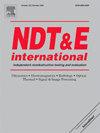Improving automatic defect recognition on GDXRay castings dataset by introducing GenAI synthetic training data
IF 4.1
2区 材料科学
Q1 MATERIALS SCIENCE, CHARACTERIZATION & TESTING
引用次数: 0
Abstract
X-rays are a Non Destructive Testing (NDT) technique commonly employed by aerospace, automotive or nuclear industries when the structural integrity of some parts needs to be guaranteed. Industrial dataset are now available with the introduction of Digital Radiography (DR) X-ray machine and are the basis for Automated Defect Recognition (ADR) systems based on Neural Network (NN) object detection models. However, building a big enough dataset is not easy and takes a long time in a production environment, delaying the introduction of ADR models. A potential solution is to use Generative Artificial Intelligence (GenAI) to synthesise new images. However, these models fail to generate full realistic images due to the subtle nature of X-ray images. Hence, this paper propose a combination of flawless images and synthetic defects generated by a novel Scalable Conditional Wasserstein GAN (SCWGAN) model. Such synthetic defects are introduced in the target images by a location algorithm that uses a mask image defining the allowable defective areas, the expected Gaussian or Poisson noise level and the defect size and aspect ratio. By creating such synthetic dataset and combine it with the original GDXRay dataset, our proposed detection system achieves an improvement of 17 % in mAP@IoU=0.5:0.95 (our target metric to reduced uncertainty on defect location) with regards the baseline model trained with only real images. As a secondary metric, to allow comparison with other studies, the model also achieves 96.0 % mAP@IoU=0.50, which exceeds the maximum accuracy available on current literature for the evaluated dataset.
求助全文
约1分钟内获得全文
求助全文
来源期刊

Ndt & E International
工程技术-材料科学:表征与测试
CiteScore
7.20
自引率
9.50%
发文量
121
审稿时长
55 days
期刊介绍:
NDT&E international publishes peer-reviewed results of original research and development in all categories of the fields of nondestructive testing and evaluation including ultrasonics, electromagnetics, radiography, optical and thermal methods. In addition to traditional NDE topics, the emerging technology area of inspection of civil structures and materials is also emphasized. The journal publishes original papers on research and development of new inspection techniques and methods, as well as on novel and innovative applications of established methods. Papers on NDE sensors and their applications both for inspection and process control, as well as papers describing novel NDE systems for structural health monitoring and their performance in industrial settings are also considered. Other regular features include international news, new equipment and a calendar of forthcoming worldwide meetings. This journal is listed in Current Contents.
 求助内容:
求助内容: 应助结果提醒方式:
应助结果提醒方式:


